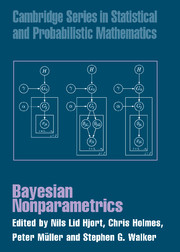Book contents
- Frontmatter
- Contents
- List of contributors
- An invitation to Bayesian nonparametrics
- 1 Bayesian nonparametric methods: motivation and ideas
- 2 The Dirichlet process, related priors and posterior asymptotics
- 3 Models beyond the Dirichlet process
- 4 Further models and applications
- 5 Hierarchical Bayesian nonparametric models with applications
- 6 Computational issues arising in Bayesian nonparametric hierarchical models
- 7 Nonparametric Bayes applications to biostatistics
- 8 More nonparametric Bayesian models for biostatistics
- Author index
- Subject index
2 - The Dirichlet process, related priors and posterior asymptotics
Published online by Cambridge University Press: 06 January 2011
- Frontmatter
- Contents
- List of contributors
- An invitation to Bayesian nonparametrics
- 1 Bayesian nonparametric methods: motivation and ideas
- 2 The Dirichlet process, related priors and posterior asymptotics
- 3 Models beyond the Dirichlet process
- 4 Further models and applications
- 5 Hierarchical Bayesian nonparametric models with applications
- 6 Computational issues arising in Bayesian nonparametric hierarchical models
- 7 Nonparametric Bayes applications to biostatistics
- 8 More nonparametric Bayesian models for biostatistics
- Author index
- Subject index
Summary
Here we review the role of the Dirichlet process and related prior distribtions in nonparametric Bayesian inference. We discuss construction and various properties of the Dirichlet process. We then review the asymptotic properties of posterior distributions. Starting with the definition of posterior consistency and examples of inconsistency, we discuss general theorems which lead to consistency. We then describe the method of calculating posterior convergence rates and briefly outline how such rates can be computed in nonparametric examples. We also discuss the issue of posterior rate adaptation, Bayes factor consistency in model selection and Bernshteĭn–von Mises type theorems for nonparametric problems.
Introduction
Making inferences from observed data requires modeling the data-generating mechanism. Often, owing to a lack of clear knowledge about the data-generating mechanism, we can only make very general assumptions, leaving a large portion of the mechanism unspecified, in the sense that the distribution of the data is not specified by a finite number of parameters. Such nonparametric models guard against possible gross misspecification of the data-generating mechanism, and are quite popular, especially when adequate amounts of data can be collected. In such cases, the parameters can be best described by functions, or some infinite-dimensional objects, which assume the role of parameters. Examples of such infinite-dimensional parameters include the cumulative distribution function (c.d.f.), density function, nonparametric regression function, spectral density of a time series, unknown link function in a generalized linear model, transition density of a Markov chain and so on.
- Type
- Chapter
- Information
- Bayesian Nonparametrics , pp. 35 - 79Publisher: Cambridge University PressPrint publication year: 2010
- 47
- Cited by

